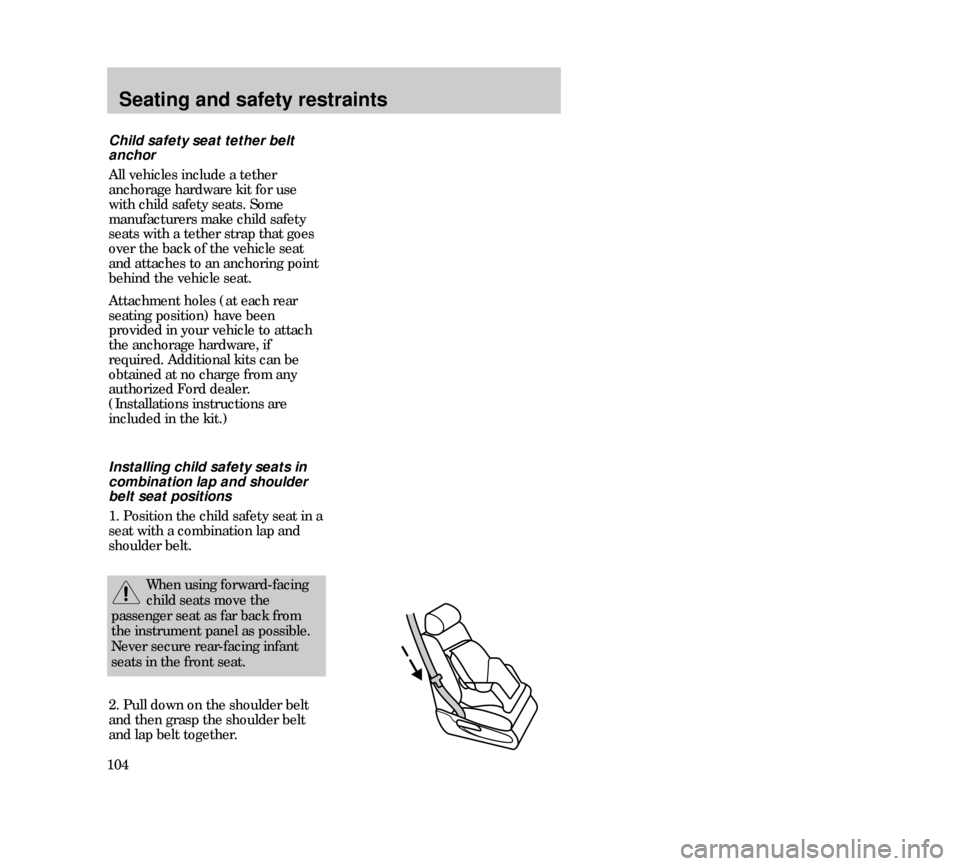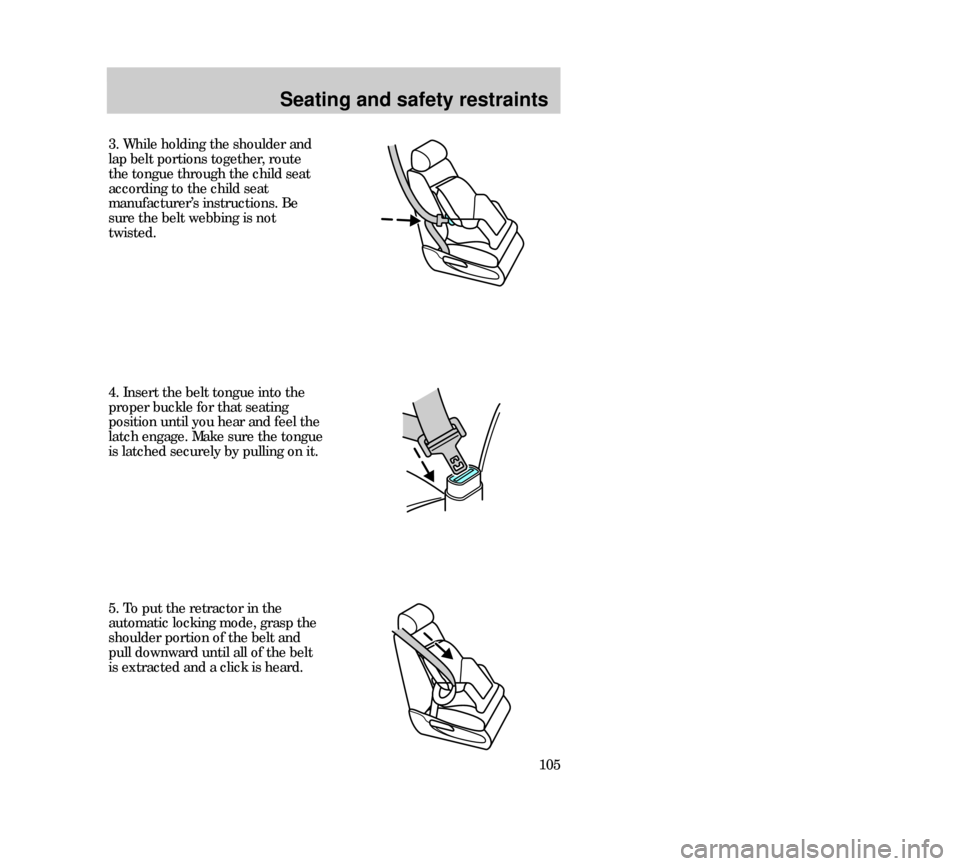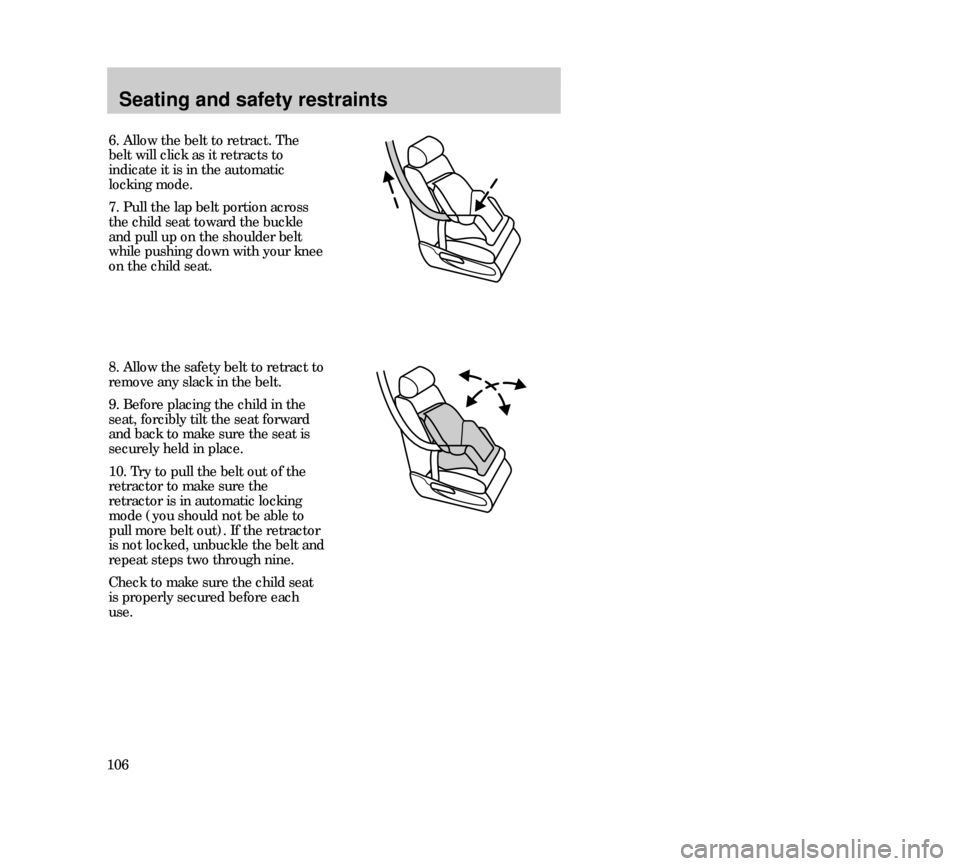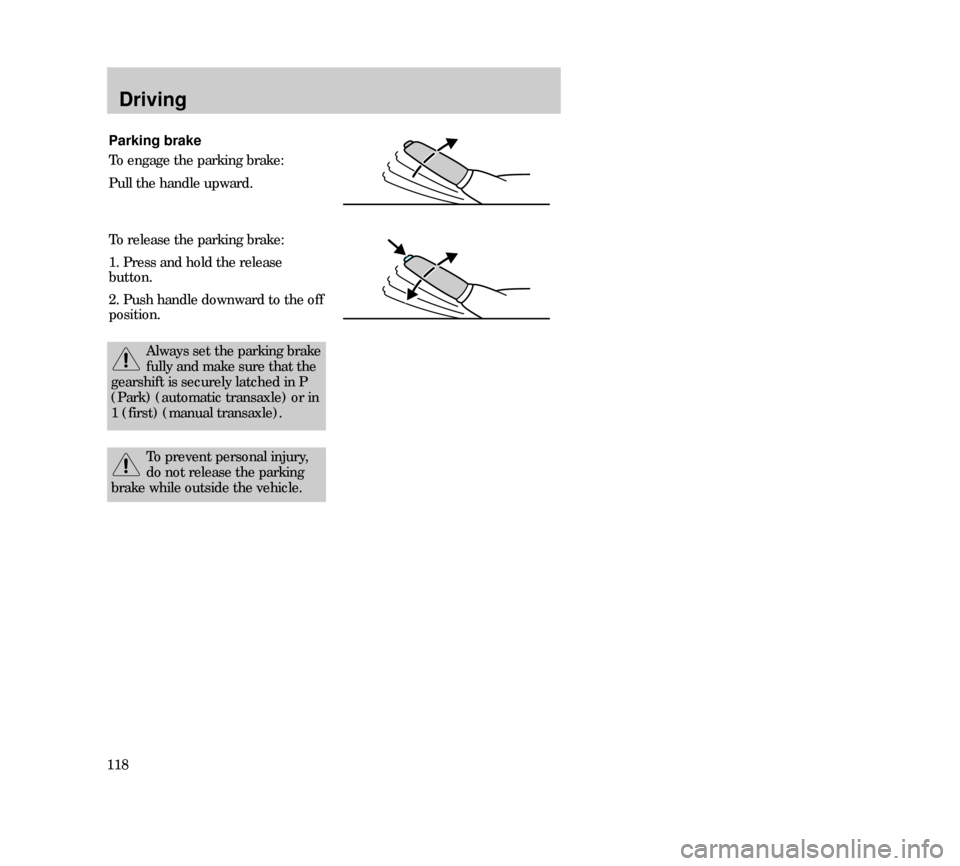ECU Mercury Mystique 2000 s User Guide
[x] Cancel search | Manufacturer: MERCURY, Model Year: 2000, Model line: Mystique, Model: Mercury Mystique 2000Pages: 248, PDF Size: 2.2 MB
Page 103 of 248

Seating and safety restraints
103
Carefully follow all of the
manufacturer’s instructions
included with the safety seat you
put in your vehicle. If you do not
install and use the safety seat
properly, the child may be injured
in a sudden stop or collision.
Ford recommends the use of a
child safety seat having a top tether
strap. Install the child safety seat in
a seating position which is capable
of providing a tether anchorage.
For more information on top tether
straps see Child safety seat tether
belt anchorin this chapter.
When installing a child safety seat:
• Use the correct safety belt
buckle for that seating postion.
• Make sure the tongue is securely
fastened in the buckle.
• Keep the buckle release button
pointing up and away from the
safety seat, with the tongue
between the child seat and the
release button, to prevent
accidental unbuckling.
• Put the safety belt in the
automatic locking mode. Refer to
Using automatic locking modein
this chapter. Child safety seats
14MSSen 24.6.99 15:16 Uhr Seite 103
Page 104 of 248

Seating and safety restraints
104Installing child safety seats in
combination lap and shoulder
belt seat positions
1. Position the child safety seat in a
seat with a combination lap and
shoulder belt.
2. Pull down on the shoulder belt
and then grasp the shoulder belt
and lap belt together.
When using forward-facing
child seats move the
passenger seat as far back from
the instrument panel as possible.
Never secure rear-facing infant
seats in the front seat.
Child safety seat tether belt
anchor
All vehicles include a tether
anchorage hardware kit for use
with child safety seats. Some
manufacturers make child safety
seats with a tether strap that goes
over the back of the vehicle seat
and attaches to an anchoring point
behind the vehicle seat.
Attachment holes (at each rear
seating position) have been
provided in your vehicle to attach
the anchorage hardware, if
required. Additional kits can be
obtained at no charge from any
authorized Ford dealer.
(Installations instructions are
included in the kit.)
14MSSen 24.6.99 15:16 Uhr Seite 104
Page 105 of 248

Seating and safety restraints
105 5. To put the retractor in the
automatic locking mode, grasp the
shoulder portion of the belt and
pull downward until all of the belt
is extracted and a click is heard. 4. Insert the belt tongue into the
proper buckle for that seating
position until you hear and feel the
latch engage. Make sure the tongue
is latched securely by pulling on it.
3. While holding the shoulder and
lap belt portions together, route
the tongue through the child seat
according to the child seat
manufacturer’s instructions. Be
sure the belt webbing is not
twisted.
14MSSen 24.6.99 15:16 Uhr Seite 105
Page 106 of 248

Seating and safety restraints
1068. Allow the safety belt to retract to
remove any slack in the belt.
9. Before placing the child in the
seat, forcibly tilt the seat forward
and back to make sure the seat is
securely held in place.
10. Try to pull the belt out of the
retractor to make sure the
retractor is in automatic locking
mode (you should not be able to
pull more belt out). If the retractor
is not locked, unbuckle the belt and
repeat steps two through nine.
Check to make sure the child seat
is properly secured before each
use.
6. Allow the belt to retract. The
belt will click as it retracts to
indicate it is in the automatic
locking mode.
7. Pull the lap belt portion across
the child seat toward the buckle
and pull up on the shoulder belt
while pushing down with your knee
on the child seat.
14MSSen 24.6.99 15:16 Uhr Seite 106
Page 118 of 248

Driving
118
Parking brake
To engage the parking brake:
Pull the handle upward.
To release the parking brake:
1. Press and hold the release
button.
2. Push handle downward to the off
position.
Always set the parking brake
fully and make sure that the
gearshift is securely latched in P
(Park) (automatic transaxle) or in
1 (first) (manual transaxle).
To prevent personal injury,
do not release the parking
brake while outside the vehicle.
22MDren 24.6.99 15:26 Uhr Seite 118
Page 122 of 248

Driving
122
Overriding the brake-shift
interlock feature
If it is necessary to use this
procedure to move the gearshift
lever, it is possible that a fuse has
blown and the vehicle’s brakelamps
may not be working. Refer to
Fuses
and relaysin the Roadside
emergencieschapter.
If you cannot move the gearshift
lever from P (Park) with the brake
pedal depressed:
1. Turn the ignition off and remove
the ignition key.
2. Apply the parking brake and the
brake pedal.
3. Insert a screwdriver or similar
item about 5 cm (2 inches) into the
square opening to the right of the
gearshift at the base of the console.
4. Rotate the screwdriver point
rearward.
5. Push and hold the thumb button
and move the gearshift.
6. Remove the screwdriver when
the gearshift moves from the P
(Park) position.
The console-mounted gearshift will
lock when you turn the key to the
lock position. When the gearshift is
in any position except P (Park),
the ignition key cannot be turned
to lock or removed from the
steering column. To remove the
key, the gearshift lever must be in
P (Park).Once the gearshift is secure in the
desired position, release the brake
pedal and use the accelerator as
necessary.
22MDren 24.6.99 15:26 Uhr Seite 122
Page 150 of 248

Roadside emergencies
150
CHANGING TIRES
Park your vehicle in such a position
that neither the traffic nor you are
hindered or endangered when
changing the tire. Ensure that the
vehicle is on firm, level ground.
Secure your vehicle further by
blocking the wheels.
Activate the hazard lights.
Apply the parking brake and
engage first or reverse gear if the
vehicle has a manual transaxle or, if
the vehicle has an automatic
transaxle, select the P (Park)
position.
If parking on a slope is unavoidable,
block the wheels.
The temporary spare tire
The vehicle may have a high
pressure temporary spare tire. This
spare is smaller than a regular tire
and is designed for emergency use
only. This tire should be replaced
as soon as possible.
If you use the temporary
spare tire continuously or do
not follow these precautions, the
tire could fail, causing you to lose
control of the vehicle, possibly
injuring yourself or others.
23MREen 24.6.99 15:28 Uhr Seite 150
Page 152 of 248

Roadside emergencies
152Removing a tire
1. Apply the parking brake and 1
(first) gear (manual transaxle) or
the P (Park) position (automatic
transaxle).
2. Activate the hazard flashers.
3. The driver and all passengers
must leave the vehicle.
4. Secure the vehicle against rolling
or sliding.
5. Insert the tapered end of the
jack handle between the rim and
hub cover and push in. Twist off to
remove the cover.
6. Loosen the wheel nuts slightly. Tire changing procedure
7. Place jack with complete support
surface on the ground.
8. The jack must be applied exactly
vertical to the jacking point of the
vehicle.
9. Jack up the vehicle until the tire
is clear of the ground. Unscrew and
remove the wheel nuts and remove
the wheel.
23MREen 24.6.99 15:28 Uhr Seite 152
Page 153 of 248

Roadside emergencies
153 Replacing a tire
1. Push the spare tire onto the
wheel studs.
2. Screw on the wheel nuts,
ensuring the tapered end of the
wheel nuts are facing the wheel,
and secure in a clockwise direction.
3. Lower the vehicle and remove
the jack by turning the handle
counterclockwise.
4. Fully tighten the wheel nuts in a
crosswise pattern.
5. Align the hub cap with the valve
and push firmly into position with
the ball of the hand.
6. Stow the jack and damaged tire
in the luggage compartment by
reversing the spare tire removal
instructions.
3
42 1
23MREen 24.6.99 15:28 Uhr Seite 153
Page 164 of 248

Maintenance and care
164Working with engine off
(manual transaxle)
1. Set the parking brake, depress
the clutch and place the gearshift
in 1 (first) or R (Reverse).
2. Turn off the engine and remove
the key.
3. Block the wheels to prevent the
vehicle from moving unexpectedly.
Working with engine off
(automatic transaxle)
1. Set the parking brake fully and
ensure the gearshift is securely
latched in P (Park).
2. Turn off the engine and remove
the key.
3. Block the wheels to prevent the
vehicle from moving unexpectedly.
31MMCen 24.6.99 15:30 Uhr Seite 164